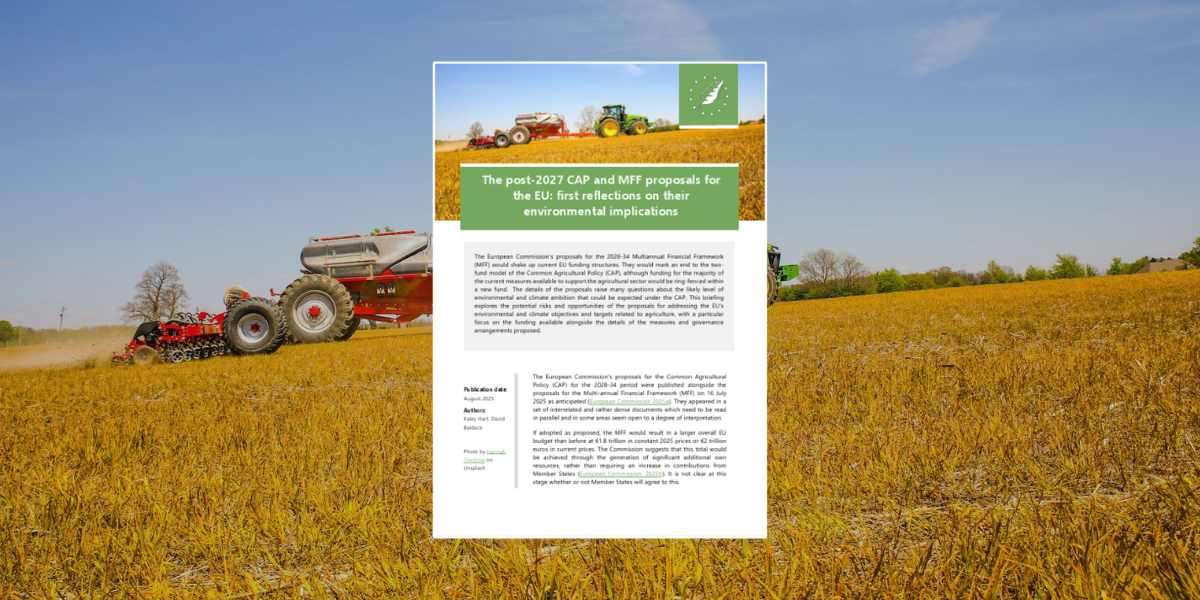AUTHORS: Kaley Hart, David Baldock
In July 2025, the European Commission published its proposal for the Multi-annual Financial Framework (MFF) and the Common Agricultural Policy (CAP) for the 2028-34 period. This briefing provides initial reflections on whether they provide the mechanisms and scale of funding needed to drive progress to meeting the EU’s sustainability objectives and targets for the coming decade.
The MFF proposal, if adopted, would see an increased EU overall budget of €2 trillion in current prices. Amongst the proposed changes to the MFF is a closer alignment with the Commission’s current priorities (i.e. security, defence, improved competitiveness, and significantly greater flexibility to adapt to unforeseen events), while references to the environment, climate, sustainability, and resilience more broadly, appear to be a lesser priority compared to the current MFF. The main innovation in the new MFF is a reorganisation into fewer, broader funding headings. The CAP is now included within a newly created fund — the “European Fund for Economic, Social and Territorial Cohesion, Agriculture and Rural, Fisheries and Maritime, Prosperity and Security”— alongside policies like Cohesion Policy. Together, CAP and Cohesion allocations make up the majority of this fund. Member States are expected to outline their use of the funding through National and Regional Partnership Plans (NRPPs) covering the full seven-year period.
This briefing, focusing primarily on the CAP, considers whether the proposals are likely to support the much-needed transition towards a more sustainable agriculture, and land use sector in the EU following some questions we raised in an earlier paper.
Overall, the review of the draft regulations suggests far less of an emphasis on the environment and climate than is currently the case, and that the timely opportunity to make a step change in the environmental performance of the CAP has not been taken. Amongst the key findings to highlight are:
- Environment and climate objectives have been downgraded and are missing from the core objectives of the NRPF.
- There are no longer any ring-fencing requirements for environmental and climate funding under the CAP nor are there any environmental schemes that are 100% EU funded.
- A far greater number of measures are compulsory for Member States to put in place; creating a significant risk that Member States will not be incentivised, or even in a position to prioritise as much of their budgets to environmental and climate action as is currently the case.
- Conditionality requirements (farm stewardship) are being weakened in favour of providing farmers with incentives to take action.
Nonetheless there are some welcome elements: degressivity, capping and targeting of area-based income support payments starts the process of re-directing the core support measure within the CAP in a new direction and Member States will have the opportunity to make more progressive choices in some areas of expenditure than they do now, if they choose to do so, including more creative use of combined CAP and Cohesion measures.
A fuller analysis is required before a detailed set of recommendations for change can be put forward. However, it is clear that a considerable number of changes to the current suite of proposed regulations would be needed to give environmental and climate priorities the prominence and focus they require. These include:
- Environmental and climate objectives be given greater prominence by including them within the core NRPF objectives.
- An environmental ring-fencing requirement should be reinstated within the ‘income support’ element of the CAP.
- Restore 100% EU funding to a substantive element of the agri-environmental and climate actions intervention to incentivise Member States to maintain or increase funding to this intervention.
- Reduce the number of interventions that are mandatory for Member States to offer.
- Re-strengthen the ‘farm stewardship’ conditionality requirements so that they genuinely provide a sustainability baseline underpinning CAP support and find ways to ensure that CAP support genuinely complies with the ‘Do No Significant Harm’ principle.
- Strengthen the governance regime proposed to ensure that it includes meaningful environmental impact indicators and makes a clear and binding link to meeting EU environmental targets applicable to the agriculture sector.
- Given the greater flexibilities and discretion given to Member States, ensure the approval processes for the NRPPs are sufficiently robust to ensure environmental and climate needs are addressed appropriately and given the necessary prominence.
Photo by Hannah Shedrow on Unsplash

